Nationwide Hispanic Heritage Month, which begins in the US every year on Sept. 15, celebrates U.S. Latinos, their tradition and their historical past. Began in 1968 by Congress as Hispanic Heritage Week, it was expanded to a month in 1988. The celebration begins in the midst of September to coincide with independence days in a number of Latin American international locations: Guatemala, Honduras, El Salvador, Nicaragua and Costa Rica rejoice theirs on Sept. 15, adopted by Mexico on Sept. 16, Chile on Sept. 18 and Belize on Sept. 21.
Listed here are some key info in regards to the U.S. Latino inhabitants by geography and by traits resembling language use and origin group.
As a part of our ongoing analysis about Hispanics in the US, we analyzed how this group has modified over time utilizing information from the U.S. Census Bureau. The decennial census (PL94-171 census information) offered some historic state and nationwide inhabitants counts, and inhabitants estimates offered the most recent information on whole inhabitants, births and immigration.
We additionally examined traits of the U.S. Hispanic inhabitants utilizing the American Group Survey (ACS), which gives information for states and the U.S. on Hispanic origin, language use, nation of delivery and academic attainment. Information from the 2022 ACS and a few from the 2010 ACS are from tabulations launched by U.S. Census Bureau. Some ACS and census information is from Built-in Public Use Microdata Collection (IPUMS) of the College of Minnesota.
The U.S. Hispanic inhabitants reached 63.6 million in 2022, up from 50.5 million in 2010. The 26% improve within the Hispanic inhabitants was sooner than the nation’s 8% development fee however slower than the 34% improve within the Asian inhabitants. In 2022, Hispanics made up practically one-in-five individuals within the U.S. (19%), up from 16% in 2010 and simply 5% in 1970.
Hispanics have performed a serious position in U.S. inhabitants development over the previous decade. The U.S. inhabitants grew by 24.5 million from 2010 to 2022, and Hispanics accounted for 53% of this improve – a higher share than another racial or ethnic group. The following closest group is non-Hispanic individuals who establish with two or extra races. Their inhabitants grew by 8.4 million throughout this time, accounting for 34% of the general improve.
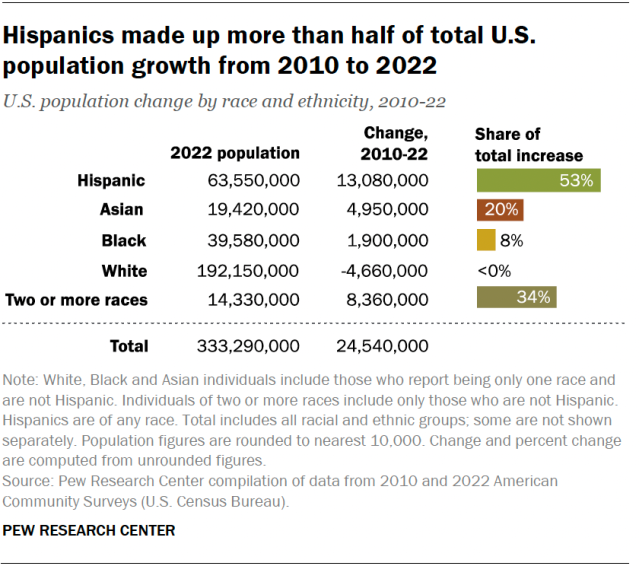
The variety of Latinos who say they’re multiracial has elevated dramatically. Greater than 27 million Latinos recognized with multiple race in 2022, up from 3 million in 2010. The rise could possibly be on account of a number of components, together with modifications to the census kind that make it simpler for individuals to pick out a number of races and rising racial variety.

Progress within the variety of multiracial Latinos comes primarily from those that establish as no less than one particular race and “another race” (i.e., those that write in a response). This inhabitants grew from 2.1 million to 24.9 million between 2010 and 2022 and now represents about 91% of multiracial Latinos. The rise was due nearly fully to development within the quantity of people that recognized as White and another race, in keeping with the 2020 census.
On the similar time, the variety of Latinos who recognized as White and no different race declined from 26.7 million in 2010 to 10.7 million in 2022.
The roughly 37.4 million individuals of Mexican origin within the U.S. represented practically 60% of the nation’s Hispanic inhabitants in 2022. These of Puerto Rican origin are the following largest group, at 5.9 million, which doesn’t embrace one other roughly 3.2 million Puerto Ricans who lived on the island in 2022. The U.S. inhabitants of Puerto Rican origin has grown partly on account of individuals shifting from Puerto Rico to the 50 states and the District of Columbia.
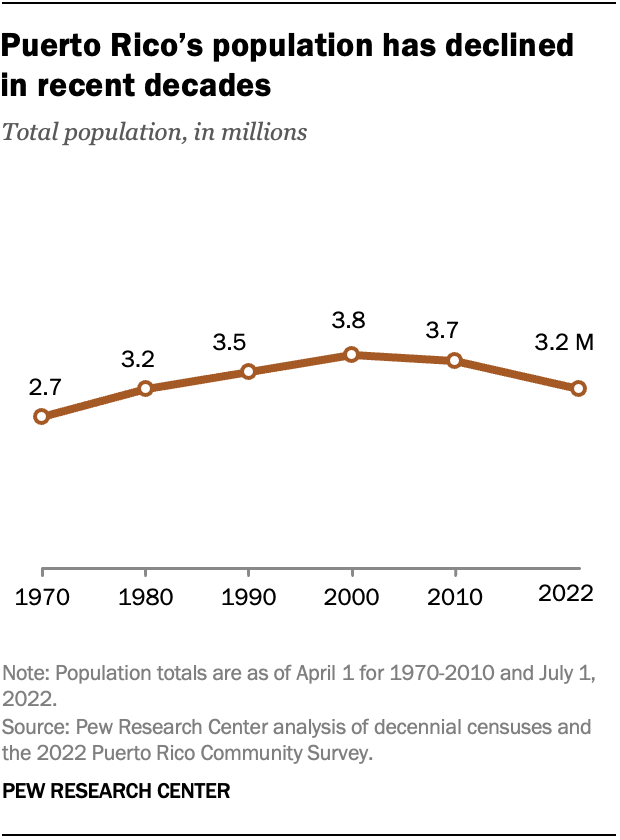
Six different Hispanic origin teams within the U.S. every have 1 million or extra individuals: Salvadorans, Cubans, Dominicans, Guatemalans, Colombians and Hondurans. As well as, in 2022, Spaniards accounted for practically 1 million U.S. Latinos.
Puerto Rico’s inhabitants has declined by about 500,000 since 2010, from 3.7 million to three.2 million. Puerto Rico has skilled a internet inhabitants loss since no less than 2005, pushed by low fertility charges and migration to the U.S. mainland. An ongoing financial recession and devastation from hurricanes Maria and Irma in 2017 have additionally contributed to the decline.
Venezuelans have seen the quickest inhabitants development amongst U.S. Latinos. From 2010 to 2022, the Venezuelan-origin inhabitants within the U.S. elevated by 236% to 815,000. 4 different teams noticed development charges exceeding 50%: Hondurans elevated by 67%, adopted by Guatemalans (62%), Dominicans (59%) and Colombians (51%).
Against this, the variety of individuals of Mexican origin within the U.S. grew by solely 14%, by far the slowest fee among the many most populous origin teams.
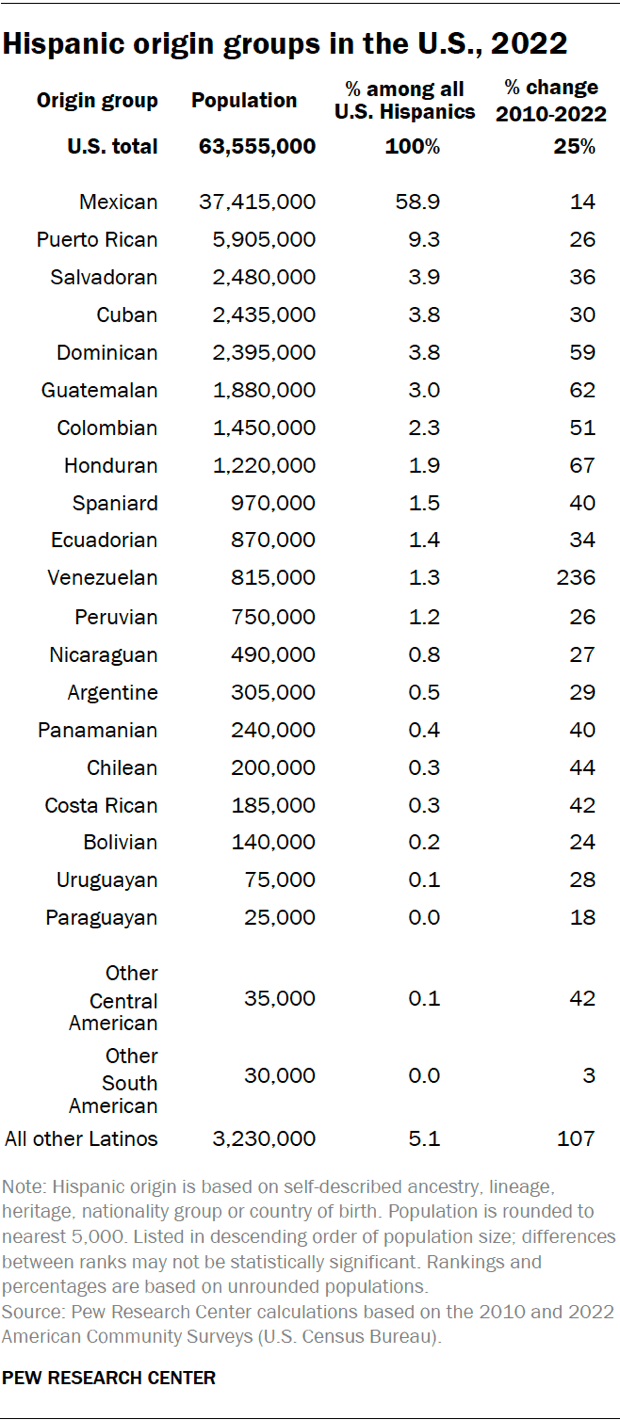
Hispanics are the most important racial or ethnic group in California and Texas. This demographic milestone in California occurred in 2014 and was a primary for the state with the nation’s largest Hispanic inhabitants. Latinos accounted for 40% of California’s inhabitants in 2022, among the many biggest shares within the nation.
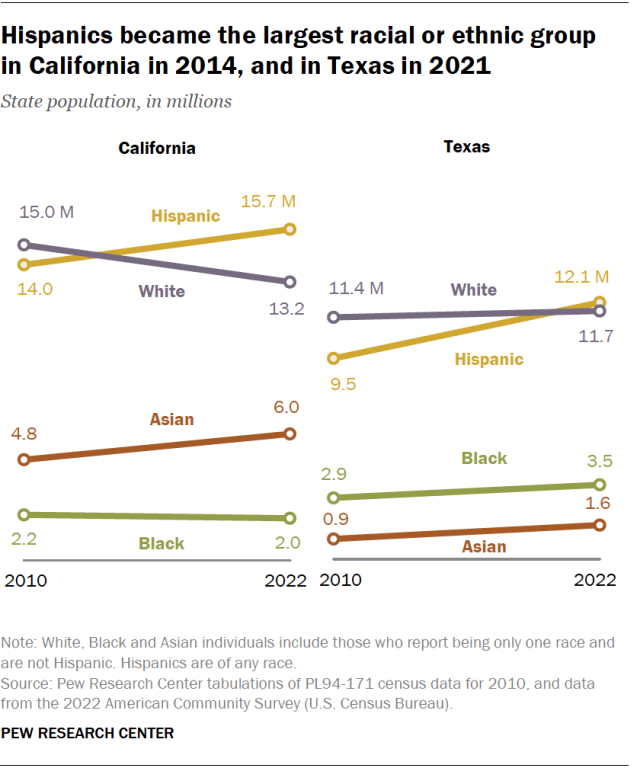
That yr, there have been about 15.7 million Hispanics in California, up from 14.0 million in 2010. The non-Hispanic White inhabitants, the following largest group, declined from 15.0 million to 13.2 million throughout this time, reflecting a broader nationwide development.
In Texas, the state with the following largest Latino inhabitants (12.1 million), Latinos additionally made up 40% of the inhabitants in 2022 and have become the most important racial or ethnic group in 2021. In Florida, the state with the third-largest Latino inhabitants (6.0 million), Latinos made up 27% of residents.
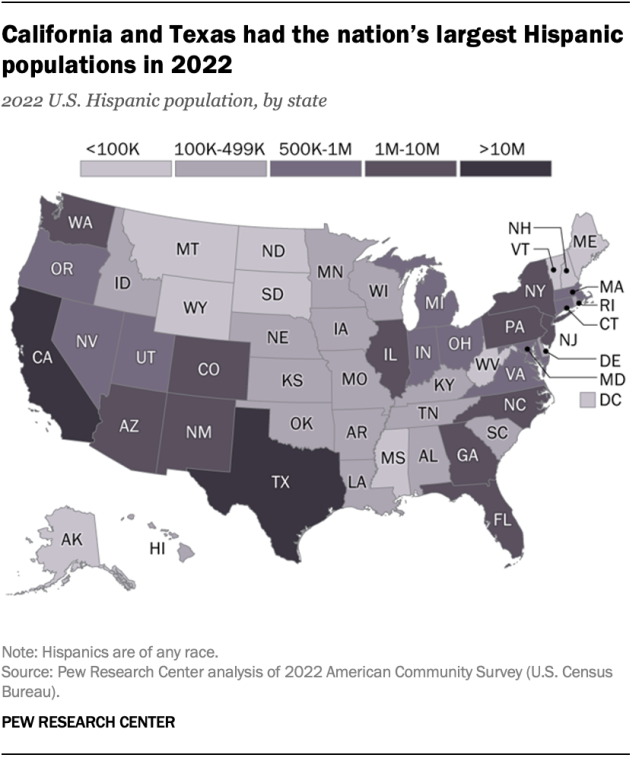
Rounding out the highest 5 states with the most important Hispanic populations have been New York (3.9 million) and Arizona (2.4 million). Eight extra states had 1 million or extra Hispanics: Illinois, New Jersey, Colorado, Georgia, Pennsylvania, North Carolina, Washington and New Mexico.
Vermont had the nation’s smallest Latino inhabitants (15,000) in 2022, adopted by Maine (29,000), West Virginia and North Dakota (34,000 every), and South Dakota (42,000).
In New Mexico, Hispanics have been a majority of the inhabitants since 2021 and the state’s largest racial or ethnic group for the reason that early 2000s. In 2022, the state was residence to 1.1 million Hispanics.
Three states’ Hispanic populations elevated by greater than 1 million from 2010 to 2022. Texas (2.5 million improve), Florida (1.8 million) and California (1.6 million) accounted for nearly half of the expansion nationwide since 2010. Arizona (480,000 improve), New Jersey (464,000) and New York (432,000) had the next-biggest will increase. All 50 states and the District of Columbia have seen development of their Hispanic populations since 2010.
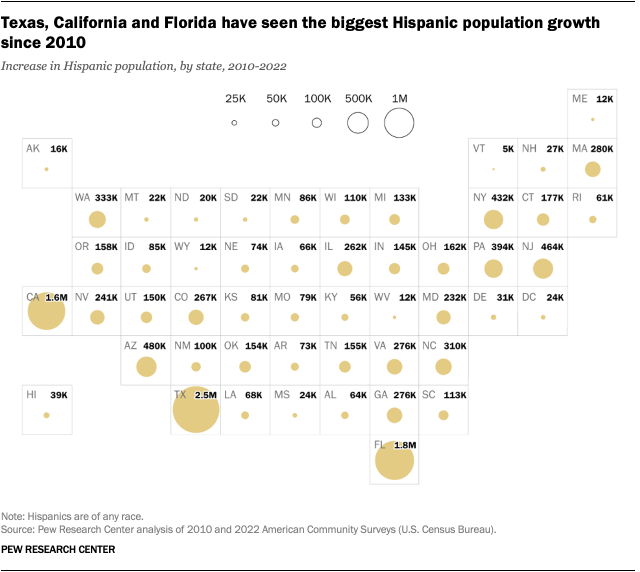
North and South Dakota’s Hispanic populations have grown the quickest since 2010. The variety of Hispanics in North and South Dakota greater than doubled (146% and 107% will increase, respectively) from 2010 to 2022. However even with that development, these states every had fewer than 45,000 Hispanics in 2022, among the many smallest populations within the nation.
The slowest development was in New Mexico (10% improve), California (12%), and Illinois and New York (13% every), all states with important Hispanic populations.
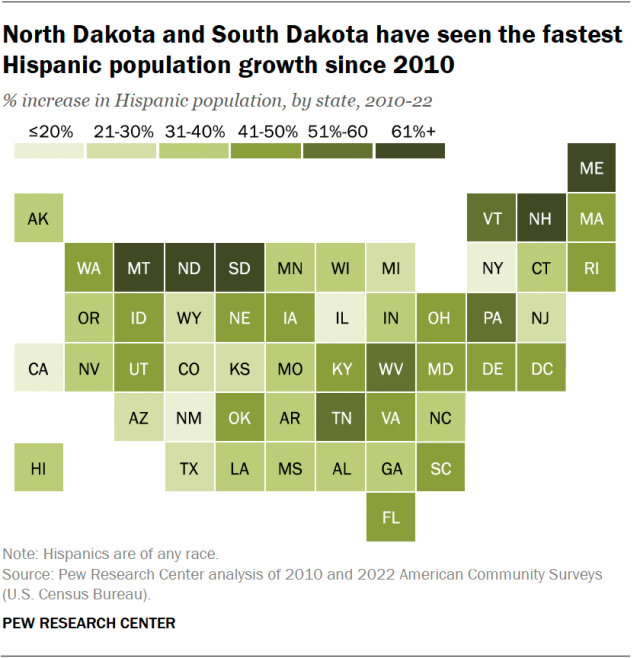
The make-up of the U.S. Hispanic inhabitants varies extensively throughout main metropolitan areas. Many of the metro areas within the Midwest, West and South with the most important Hispanic populations are predominantly Mexican. About three-quarters of Hispanics within the Chicago (77%) and Los Angeles (75%) areas establish as Mexican, as do 67% within the Houston space.
Metro areas within the Northeast are inclined to have extra various Hispanic origins. For instance, no origin group makes up greater than 30% of the New York and Boston metro areas’ Hispanic populations.
Metro areas in Florida and the nation’s capital have distinctive Hispanic enclaves. Puerto Ricans make up 43% of Hispanics within the Orlando space, whereas Cubans make up 39% of Hispanics within the Miami space. Within the Washington, D.C., metro space, Salvadorans account for 30% of Hispanics.
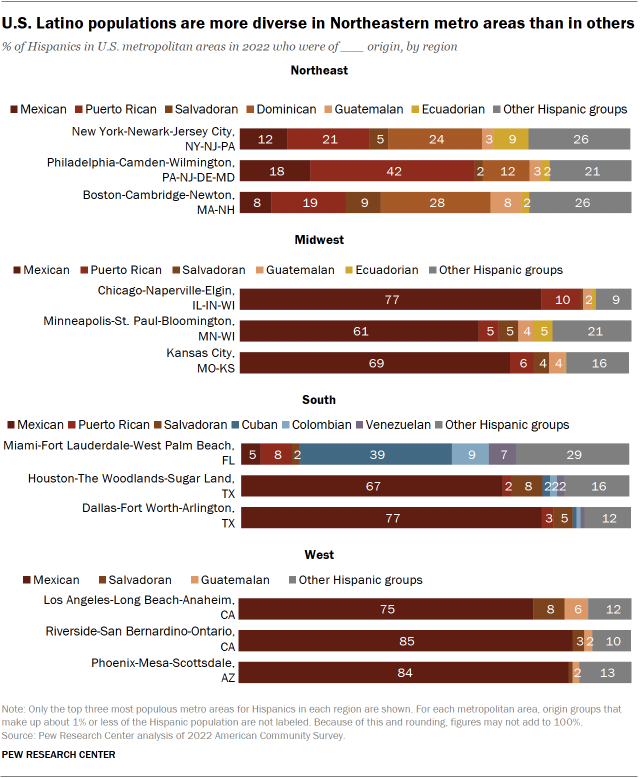
Catholics stay the most important spiritual group amongst Latinos within the U.S., however they’ve develop into a smaller share of the Latino inhabitants over the previous decade. In 2022, 43% of Latinos adults establish as Catholic, down from 67% in 2010. In the meantime, 30% of Latinos are religiously unaffiliated (describing themselves as atheist, agnostic or “nothing specifically”), up from 10% in 2010. The share of Latinos who establish as Protestants – together with evangelical Protestants – has been comparatively steady.

Newborns, not immigrants, have pushed the current development amongst U.S. Hispanics. In the course of the 2010s, a mean of 1 million Hispanic infants have been born every year, barely greater than throughout the 2000s. On the similar time, about 350,000 Hispanic immigrants arrived yearly, down considerably from the earlier twenty years.
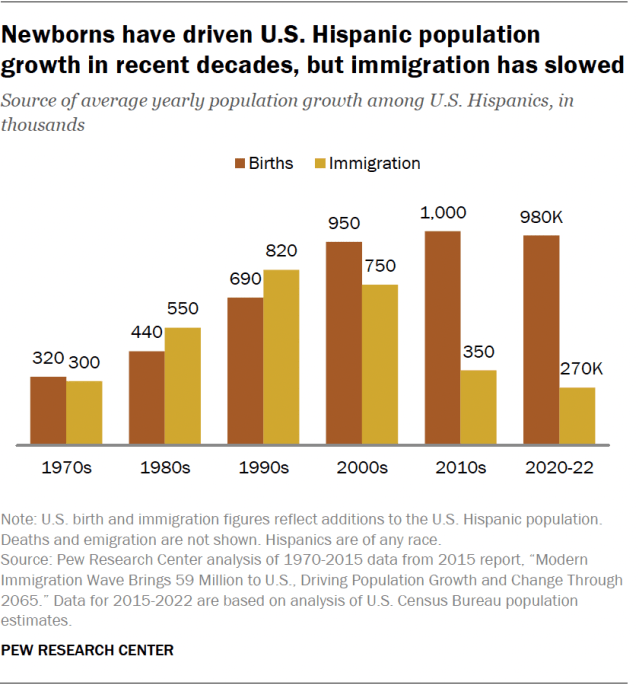
The current predominance of recent births over immigration as a supply of Hispanic inhabitants development is a reversal of historic traits. Within the Nineteen Eighties and Nineteen Nineties, immigration drove Hispanic inhabitants development.
From 2020 to 2022, common annual births amongst Hispanics have been barely under the earlier decade, however immigration decreased significantly, from 350,000 per yr to 270,000. A few of this decline may be attributed to immigration into the U.S. stopping nearly fully throughout the early phases of the COVID-19 pandemic. With the removing of pandemic-related restrictions, the contribution of immigration to Hispanic development seems to be returning to early 2010s ranges.
The share of Latinos within the U.S. who communicate English proficiently is rising. In 2022, 72% of Latinos ages 5 and older spoke English proficiently, up from 59% in 2000. U.S.-born Latinos are driving this development: The share of U.S.-born Latinos who communicate English proficiently elevated by 9 share factors in that span, in contrast with a 5-point improve amongst Latino immigrants. All instructed, 42.3 million Latinos within the U.S. spoke English proficiently in 2022.

On the similar time, the share of Latinos who communicate Spanish at residence declined from 78% in 2000 to 68% in 2022, and most of that decline was among the many U.S. born.
Regardless that the share of Latinos who communicate Spanish at residence has declined, the quantity who accomplish that has grown from 24.6 million in 2000 to 39.7 million in 2022 due to the general development within the Latino inhabitants.
The share of U.S. Hispanics with faculty expertise has elevated since 2010. About 45% of U.S. Hispanic adults ages 25 and older had no less than some faculty expertise in 2022, up from 36% in 2010. The share of Hispanics with a bachelor’s diploma or extra schooling additionally elevated, from 13% to twenty%. The share with a bachelor’s diploma or increased elevated extra amongst Hispanic girls (from 14% to 22%) than Hispanic males (12% to 18%).
The variety of Latinos enrolled in faculty or postgraduate schooling additionally elevated between 2010 and 2022, from 2.9 million to 4.2 million. Amongst all U.S. undergraduate and graduate college students, the share of Latinos elevated from 14% in 2010 to twenty% in 2022, barely increased than the Latino share of the whole inhabitants.
4-in-five Latinos are U.S. residents. As of 2022, 81% of Latinos residing within the nation are U.S. residents, up from 74% in 2010. This consists of individuals born within the U.S. and its territories (together with Puerto Rico), individuals born overseas to American mother and father, and immigrants who’ve develop into naturalized residents. The Middle lately printed citizenship charges amongst Hispanic origin teams for 2021; this information shouldn’t be but obtainable for 2022.
Word: This publish has been often up to date because it was initially printed on Sept. 16, 2014.






























































